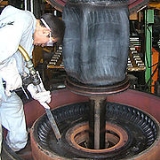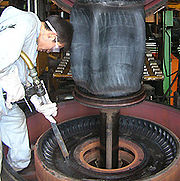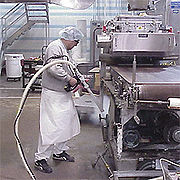
Dry ice blasting
Encyclopedia

Abrasive blasting
Abrasive blasting is the operation of forcibly propelling a stream of abrasive material against a surface under high pressure to smooth a rough surface, roughen a smooth surface, shape a surface, or remove surface contaminants. A pressurized fluid, typically air, or a centrifugal wheel is used to...
, where dry ice
Dry ice
Dry ice, sometimes referred to as "Cardice" or as "card ice" , is the solid form of carbon dioxide. It is used primarily as a cooling agent. Its advantages include lower temperature than that of water ice and not leaving any residue...
, the solid form of carbon dioxide
Carbon dioxide
Carbon dioxide is a naturally occurring chemical compound composed of two oxygen atoms covalently bonded to a single carbon atom...
, is accelerated in a pressurized air stream and directed at a surface in order to clean it.
The method is similar to other forms of abrasive blasting such as sand blasting, plastic bead blasting, or soda blasting but substitutes dry ice as the blasting medium. Dry-ice blasting leaves no chemical residue as dry ice sublimates at room temperature
Room temperature
-Comfort levels:The American Society of Heating, Refrigerating and Air-Conditioning Engineers has listings for suggested temperatures and air flow rates in different types of buildings and different environmental circumstances. For example, a single office in a building has an occupancy ratio per...
.
Method
Dry-ice blasting involves propelling pellets at extremely high speeds. The actual dry-ice pellets are quite soft, and much less dense than other media used in blasting-cleaning (i.e. sand or plastic pellets). Upon impact, the pellet sublimates almost immediately, transferring minimal kinetic energyKinetic energy
The kinetic energy of an object is the energy which it possesses due to its motion.It is defined as the work needed to accelerate a body of a given mass from rest to its stated velocity. Having gained this energy during its acceleration, the body maintains this kinetic energy unless its speed changes...
to the surface on impact and producing minimal abrasion. The sublimation process absorbs a large volume of heat from the surface, producing shear stress
Shear stress
A shear stress, denoted \tau\, , is defined as the component of stress coplanar with a material cross section. Shear stress arises from the force vector component parallel to the cross section...
es due to thermal shock
Thermal shock
Thermal shock is the name given to cracking as a result of rapid temperature change. Glass and ceramic objects are particularly vulnerable to this form of failure, due to their low toughness, low thermal conductivity, and high thermal expansion coefficients...
. This is assumed to improve cleaning as the top layer of dirt or contaminant is expected to transfer more heat than the underlying substrate and flake off more easily. The efficiency and effectiveness of this process depends on the thermal conductivity of the substrate and contaminant. The rapid change in state from solid to gas also causes microscopic shock wave
Shock wave
A shock wave is a type of propagating disturbance. Like an ordinary wave, it carries energy and can propagate through a medium or in some cases in the absence of a material medium, through a field such as the electromagnetic field...
s, which are also thought to assist in removing the contaminant.
Equipment
The ice used can be in solid pellet or shaved ice block forms. The shaved ice block produces a less dense ice medium and is more delicate than the solid pellet system.Dry ice blasting generally uses one of two delivery systems to combine compressed air with ice and accelerate particles out of the delivery nozzle:
Single-hose technology was developed by Cold Jet, LLC in 1986, and uses a single hose to deliver air blasts and dry ice. The single hose system can use a longer hose than the double-hose counterpart without a significant drop in pressure when the ice leaves the hose. The additional power comes at the cost of increased complexity. Single-hose systems are used when the surface to be cleaned has a heavier build-up or when the surface to be cleaned is vertical or at a greater height than the hopper
Hopper
Hopper may refer to:-Mechanical parts:* A general term for a chute with additional width and depth for temporary storage* Hopper , a large container used for dust collection* Part of a combine harvester...
and gas compressor
Gas compressor
A gas compressor is a mechanical device that increases the pressure of a gas by reducing its volume.Compressors are similar to pumps: both increase the pressure on a fluid and both can transport the fluid through a pipe. As gases are compressible, the compressor also reduces the volume of a gas...
.
Two-hose dry-ice blasting was developed before the single-hose system. Compressed air is delivered in one hose, and ice pellets were sucked out of a second hose by the venturi effect
Venturi effect
The Venturi effect is the reduction in fluid pressure that results when a fluid flows through a constricted section of pipe. The Venturi effect is named after Giovanni Battista Venturi , an Italian physicist.-Background:...
. Compared with a single-hose system, the two-hose system delivers ice pellets with less force (approximately 5% for a given air supply) than a single-hose system. Theoretically two-hose systems have a limit to the vertical distance between the machine and applicator. This limit however is well in excess of 25 feet. Two-hose systems are generally less costly to produce due to a much simpler delivery system and they allow finer particles of ice to be delivered with lower velocity as the late combination of warm air with cold ice results in less sublimation in the hose. The latter properties allow for more delicate surfaces to be cleaned.
Uses

Dry-ice blasting can be used to clean many different applications including:
- Turbines and generators used in the power generation industry
- Printing presses and other paper industry related machinery
- Fire, soot and smoke damage
- Mold, spore and mildew remediation
- Plastic and rubber molding equipment including injection and extrusion molds
- Paint preparation including paint stripping
Safety
Carbon dioxide is increasingly toxic starting at concentrations above 1% , and can also displace oxygenOxygen
Oxygen is the element with atomic number 8 and represented by the symbol O. Its name derives from the Greek roots ὀξύς and -γενής , because at the time of naming, it was mistakenly thought that all acids required oxygen in their composition...
resulting in asphyxia
Asphyxia
Asphyxia or asphyxiation is a condition of severely deficient supply of oxygen to the body that arises from being unable to breathe normally. An example of asphyxia is choking. Asphyxia causes generalized hypoxia, which primarily affects the tissues and organs...
if equipment is not used in a ventilated area. In addition, because carbon dioxide is heavier than air, exhaust vents are required to be at or near ground level to efficiently remove the gas. At normal pressure dry ice is -78 C and must be handled with insulated gloves. Eye and ear protection are required to safely use dry ice cleaning equipment. Compared to other blasting-cleaning methods, dry ice blasting produces fewer waste products and does not require clean-up of a blasting medium.
History
The first patent regarding dry-ice technology was , issued in 1947.The first patents regarding development and design of modern-day single-hose dry-ice blasting technology were awarded to David Moore of Cold Jet, LLC in 1986, 1988 ( and ).

